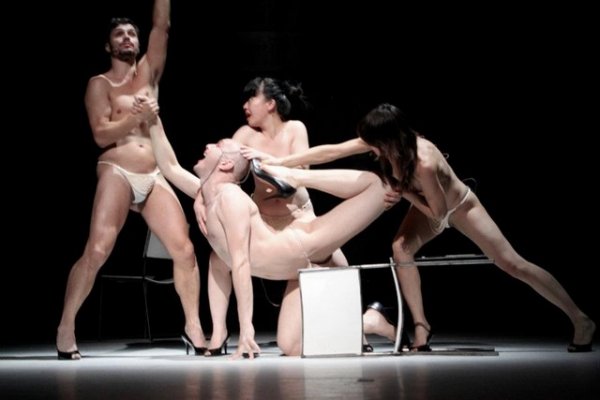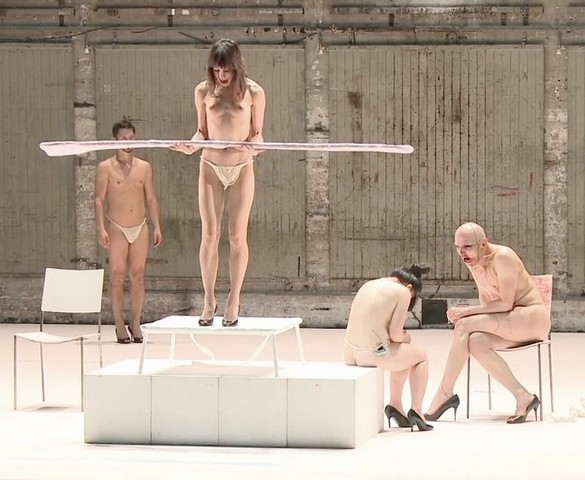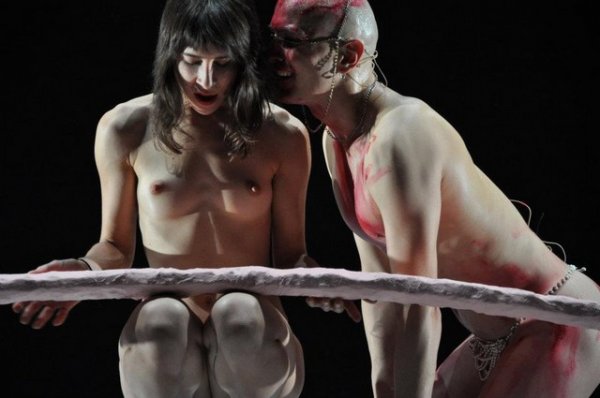Ivo Dimchev's recent performance, X-ON, continues the investigation of Franz West's sculptures named Adaptives, but it does it in a different manner from the one he displayed in another performance, I-ON. If in I-ON the artistic investigation is elaborated as a structured meeting between the body of the performer and the Adaptives, X-ON introduces multiple levels of interaction, encounter and discourse.
In I-ON, the main subject in the discourse is the performative body, but it is not the body of a character, but of the performer himself. It is the "I", the performative identity of Ivo Dimchev that is "ON" the area of the discourse, of the meeting with the sculptures. In X-ON the "I" is not left behind, but transgressed up to another level of discourse, the sphere of authorship, so it becomes a meta-I, who assumes a different form of presence onstage. In this sense, the I that was ON, becomes an X-ON, an identity that is molded into the strong traces of authorship.
As we find out from the very beginning, as we are told by the character of a guide into a museum (performed by Veronica Zott), the Adaptives were created by the famous Austrian artist Franz West in the 1970s with the openly declared purpose of their interaction with the visitors of the galleries and museums. Besides the guide, Ivo Dimchev introduces two more presences onstage, the tourists (Yen Yi-tzu and Christian Bakalov). Their puzzlement is related to the issue of the danger: what if someone breaks the Adaptives?? One way out of the dilemma is the possibility of the existence of many other copies of the Adaptives in the museum that can replace any time the broken original, a vision that is openly uttered by the tourist.
The core of the problematic launched with X-ON is revealed when another presence enters the stage: Lili Handel, a character created by Ivo Dimchev in 2004 that could be seen all over the world in the performance Blood, Poetry and Music from the White Whore's Boudoir. Therefore, two topics are obvious: the problematic of authorship (the artistical meeting between Franz West on one hand and by Ivo Dimchev on the other hand) and the meeting between works of art that are substantially distinct (the sculptures and the character).
Lili Handel presents herself to the audience and starts her interaction with the sculptures; the world of the character is shaped around the art objects through different ways of interaction: singing, touching, poetry. But the encounter is moved to the other presences onstage, they are urged by Lili to name what they see, but they never seem to find the real name.
The game of naming in relation with the silent and self-contained presence of the sculptures is an important issue of the performance, that reiterates one of the main topics of the history of art and thinking: the problematic of language, of the relation between an object and its name, that can range from assuming that the hidden essence of the object requiresa certain name, to the idea that there is no essence of things and we can name them randomly. One possible clue is that the naming is always a question of relation and so we are led by Lili to another level of encounter. The character built by Dimchev invites also the spectators to interact with the sculptures, as everybody is allowed to do it, according to the very purpose that West's artworks were created for. In this kind of relating one certain thing is repeatedly pointed out by Lili Handel: she tries to make the spectators become aware of the musicality of the objects. But how can we figure out the musicality of an object? I felt that it was not anything about hearing a hidden music provoked by the sculpture.
Between musicality and music there are differences, I can hear music and perceive no musicality and I can feel musicality without the need of hearing any music at all. In this performative context I perceived musicality as the configuration in the form of a score of the meeting between the spectator and the object. This kind of relation like a score, or better said of a world in the shape of a score, would place the spectator on the same essential level with the art work. Otherwise, the interaction would remain just the reiteration of the stereotypes that the visitor of the galleries carries with him/her everywhere.
It is true, as we know from some interviews with Franz West that the Adaptives were inspired by the African art, where the split between useful objects and artworks does not exist. The problem with the visitors of the galleries is that the world they are living in is strongly marked by the discrepancy between what is useful in daily life and the function of the work of art. Feeling the musicality of the object would represent the jump into another level of understanding the objects and their relation with the bodies, by figuring out the world as a score, as a reality marked by musicality.
The invitation to feel the musicality reminded me of an attempt that I once had to elaborate a concept, the body-becoming-sound as a sound-image, starting from Deleuze's concept of body without organs. Before explaining more about this, I must say that I felt why most of the spectators would fail...Because the civil body is usually deprived of musicality and only a performative body can have it. For a civil body it is not enough that it assumes the musicality of the objects. If the body itself is deprived of musicality, if it is not at least an aware note in the score, there is no authentic interaction.
The meeting between the performative body of the character Lili Handel with the Adaptives reminded me of the idea of body-becoming-sound.
One possibility to analyze the function of the sound generated either by a score or an improvisation is to take into account the relation between a body producing the sound (through the voice) and the sound itself.
Starting from Deleuze's concept of "body without organs" (taken over from Artaud), there shows up the possibility of initiating a concept - the body-becoming-sound - which stands for a new status of the singing body: the singer is no longer an entity separated from the music it produces and the music is not a reality split from the materiality of the artist. The body-becoming-sound, within the reality of the score as a body without organs (a reality that forms and in-forms the synthesis between the body and the sound) is an entity that surpasses traditional perceptions of the body seen through different types of duality, one of them being the split between the body and the message.
The body-becoming-sound is a "body without organs" (in the deleuzian sense), generated by and at the same time generating another body without organs (the already established score, or the improvised music). The relation between the two types of body without organs is not a hierarchical one, but it is the result of a rhizomatic structure constantly deterritorialized by "lines of flight" which are generated by the tensions, meetings and clashes between the body that produces the sound, the sound itself and the music as body without organs.
There is also the possibility of regarding the body-becoming-sound as a sound-image. Therefore, the body that produces music is no longer a material reality split from the immaterial reality of the message conveyed through music. The body-becoming sound as a sound-image is the embodied message itself.
Lili Handel's body works in that sense and the musicality of the Adaptives is part of the sound-image, of the larger score that incorporated the authentic interaction between the body and the artwork.
The characters that were in the beginning identified as the guide and the tourists become the copies of Lili Handel and they initiate synchronized investigation of the Adaptives, or set up a rage of the copies against the original (Lili Handel). As long the Adaptives are in the danger of being broken, the living work of art, Lili Handel is not a stranger to this danger, too. The moment when Lili sheds her blood on the Adaptives is throwing light upon the nature of the meeting between the two kinds of works of art: the bridge between the flesh and the papier mâché will have the musicality of the blood and will remain covered in silence.
In the end, the copy of Lili that appeared at first in the hypostasis of the guide enters the stage with a huge adaptive and steps on a pedestal. She is giving out a sound, like a shriek that can vary from wonder to fear or to unspeakable revelation. Lili will leave the stage after whispering something into the girl's ear... Something that we will never know what it is. The unheard truth of the meeting, the unspeakable nature of the encounter. ... I could not help thinking of Wittgenstein and of his famous quote: "What is sayable at all, lets itself be said clearly; and what you cannot speak of, of that one should remain silent".
Lili's "no" at every name given to the objects during the performance pointed to this silence. A kind of silence that feeds on musicality.
X-ON by Ivo Dimchev / in collaboration with Franz West/
idea, text and choreography: Ivo Dimchev
original music: Philipp Quehenberger, Ivo Dimchev
light design: Giacomo Gorini
sculptures and artistic advise: Franz West
with: Yen Yi-Tzu, Veronika Zott, Christian Bakalov, Ivo Dimchev
production of Humarts Foundation
co-production of - Kaaitheater / Brussels, Theater Fraskati / Amsterdam, Impulstanz / Vienna, Volksroom / Brussels.
0 comentarii
Resurse
Alte articole de Gina ȘerbănescuCronici ale altor spectacoleArticole similare
Premiile CNDB 2019, via Descentrat - Un discurs de acceptare / Gigi CăciuleanuVals de morţi şi de vii - Grand Finale / Roxana PavnotescuEfecte speciale - Prelegeri grave de Adriana Gheorghe la CNDB / Beatrice LăpădatCorpul-ce-devine-sunet şi muzicalitatea operei de artă / Gina ȘerbănescuÎntâlnirea dintre corp şi obiect / Gina ȘerbănescuToate articolele despre 100% DansScrieţi la LiterNet
Scrieţi o cronică (cu diacritice) a unui eveniment cultural la care aţi participat şi trimiteţi-o la [email protected] Dacă ne place, o publicăm.
Vreţi să anunţaţi un eveniment cultural pe LiterNet? Îl puteţi introduce aici.
Publicitate


